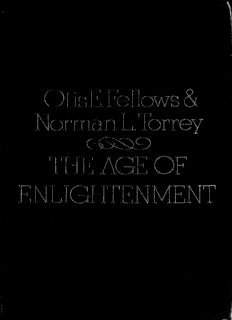
The age of enlightenment, an anthology of eighteenth-century French literature PDF
Preview The age of enlightenment, an anthology of eighteenth-century French literature
THE AGE OF ENLIGHTENMENT T h e Age of A n Anthology o f French Edited by O T I S E. F E L L O W S and NORMAN L.TO RREY Columbia University Enlightenment Eighteenth-Century Literature SECOND EDITIO N APPLETON-CENTURY-CROFTS Educational Division New York M EREDITH CORPORATION The Age of Enlightenment: An Anthology of Eighteenth-Century French Literature, Second Edition-, Edited by Otis E. Fellows and Norman L. Torrey. Copyright © 1971 by MEREDITH CORPORATION All rights reserved This book, or parts thereof, must not be used or reproduced in any manner without written permission. For information address the pub lisher, Appleton-Century-Crofts, Educational Division, Meredith Corporation, 440 Park Ave nue South, New York, N. Y. 10016. 7100-1 Library of Congress Card Number: 73-147121 Copyright © 1942 by Meredith Corporation Copyright © renewed 1970 by Otis Edward Fellows and Norman L. Torrey PRINTED IN THE UNITED STATES OF AMERICA 390-30616-9 PREFACE This book is designed as a presentation of basic material for a study of the Enlightenment. The texts have been chosen for their importance in the history of the movement of ideas and for their literary quality. The collection thus offers a background not only for the study of French eighteenth-century literature but also for courses in French historical or political thought and French civilization. The literature of the century stressed content above form. In the more formalistic genres, especially in tragedy and comedy, it fell below the standards set by the previous age, whereas in the novel, the dialogue, and minor genres, it found its most successful modes of literary expression. Here content was given form and masterpieces were produced such as Manon Lescaut, Diderot’s dialogues, and Voltaire’s comes. The editors have felt that, except in rare cases, these literary units, together with the plays of Marivaux, Voltaire, and Beaumarchais, should not be presented in fragmentary form but should be enjoyed in their entirety in the readily .1 available texts which will supplement the background material The selections are grouped by authors, under whom they are chrono logically arranged except for Diderot, whose works present a special case, and Voltaire, where grouping of ideas seemed highly desirable. Voltaire is also placed late in the volume because he summed up with such clarity and precision the more important trends of the century. It is particularly recommended, however, that his Lettres philosophiques, because of their historical importance in the movement of ideas, be read between Mon tesquieu’s Lettres persanes and Esprit des lois. It is the common observation of Europeans that the American student arrives late at intellectual maturity and that the philosophical education of our graduate students, particularly those who have specialized in lit erary fields, is decidedly limited. Eighteenth-century French literature offers a training in unsystematic philosophy which can hardly be equaled. The writers of this period were, as Gustave Lanson said of Voltaire, “a procedure, a method of education, a philosophy of life.” They present a community of ideas upon which has been built for the last century and a half every civilized form of society worthy of the name. Whether the general tendencies of the Enlightenment are approved or disapproved, they are already of tremendous historical significance. i. For example, the Classiques Larousse include: Beaumarchais, Le Barbier de Séville and Le Mariage de Figaro; Lesage, Gil Bias (extracts) and Turcaret; Marivaux, Le Jeu de Vamour et du hasard; Prévost, Manon Lescaut; Sedaine, Le Philosophe sans le savoir; Voltaire, Contes en prose (Candide, Zadig, etc., i v.). v vi Preface The following readings are therefore presented in the faith that the student will understand and judge them according to the spirit of Cardinal Newman’s well-known definition of the university as a place “where inquiry is pushed forward, and discoveries are verified and perfected, and rashness rendered innocuous, and error exposed, by the collision of mind with mind, and knowledge with knowledge.” The present revised edition is published in response to the urging of many who have used this book. Through page 263 no pagination changes have been made. After that point there have been a few deletions and a number of additions which we think will be welcome. Throughout there has been an attempt to correct errors and, when necessary, to alter word ing. YVe gratefully acknowledge the many suggestions that have come from a great variety of sources, often from our former students. Since the book was first intended to present basic texts for the use of advanced students rather than as a manual for scholars, it has been im possible to refer to many recent scholarly books and articles. The addition of further suggested reading has, however, been added at the end of the volume for those wishing to extend their understanding of the age. O. E. F. N. L. T. CONTENTS General Introduction 1 Precursors CYRANO DE BERGERAC 19 Voyage dans la lune 20 SAINT-EVREMOND 34 Conversation du maréchal d’Hocquincourt avec le père Canaye 35 FONTENELLE 39 Dialogues des morts 40 Digression sur les anciens et les modernes 49 Entretiens sur la pluralité des mondes 51 L’Origine des fables 60 L’Histoire des oracles 63 BAYLE 67 Pensées diverses sur la comète 67 Commentaire philosophique sur ces paroles de Jésus-Christ: Contrains-les d’entrer 76 Dictionnaire historique et critique 79 FENELON 90 Lettre à Louis XIV 91 Télémaque 95 Montesquieu 100 Lettres persanes 103 Considérations sur les causes de la grandeur des Romains et leur décadence 137 De l’esprit des lois 143 vii
